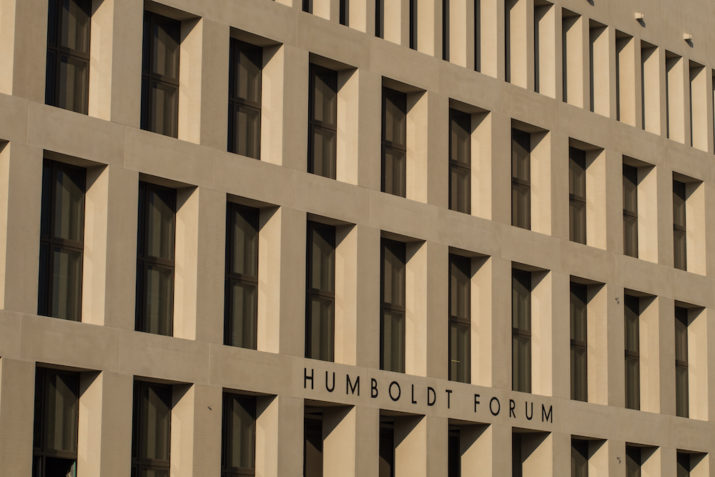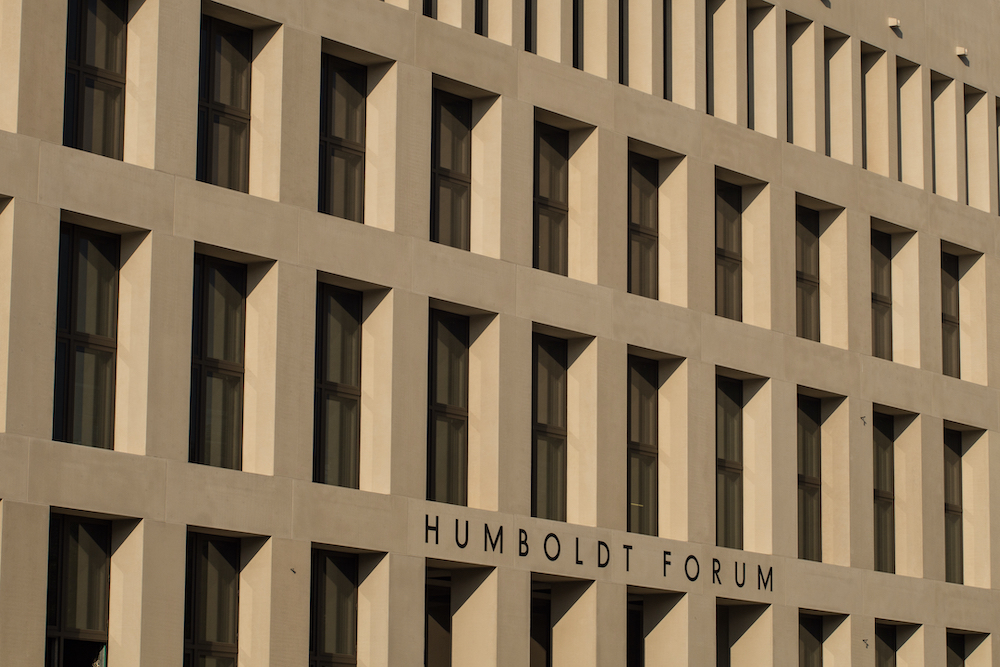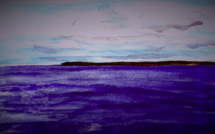

This is part of our special feature on European Art, Culture, and Politics.
“Finally—Berlin has its palace again!” heralded a Deutsche Welle article from 2018.[1] Despite the enthusiastic headline, the reconstruction of the imperial palace on Berlin’s central Schloßplatz has been the subject of much debate even before former German President Joachim Gauch laid the foundation stone in June 2013, signaling the launch of the €595M project which, as of early April, is slated to open in late 2020. Transformed from its sixteenth-century autocratic function as the royal seat of the Hohenzollern dynasty into a globally-oriented space for the public that seeks to showcase Berlin’s historical and contemporary links to the world, much of the attention focused on the building has surrounded a new major museum which will open in the palace. Dubbed the “Humboldt Forum” in reference to imperial-era explorer Alexander von Humboldt, the forum promises to function as a modern museum that will house Berlin’s non-Western art collections. The institution intends to bring the collections of the Berlin’s Asian Art Museum and Ethnological Museum together, transferring them from their post-war location in Dahlem (a distant suburb) into the very center of the German capital itself, signaling a desire to include non-European narratives within public institutional memory.
The reconstruction of the major Berlin landmark has fostered debate about the ways in which Germany continues to come to terms with its (short but brutal) colonial past, particularly in reference to the repatriation of objects, which were looted during the era. In many ways, this scrutiny mirrors broader institutional debates about imperialism, ownership and the return of stolen goods taking place on both a European and a global level. These difficult conversations have long provided a backdrop for the collections of Western museums, even emerging as a “soft power” function of political discourse within Europe itself, as in the case of the Elgin Marbles which the European Union has asked the government of the United Kingdom to return to Greece in order to secure a post-Brexit trade deal.[2] Ethnographic museums in particular have been the subject of these conversations, their collections and methodologies often at odds with contemporary societal values. The Humboldt Forum is the most recent of a chain of museums across western Europe, which have taken to simultaneously ideologically “renovating” their collections and modernizing the institutions which hold them; alongside the Musee de l’homme in Paris, the Tropenmuseum in Amsterdam, the Koninklijk Museum voor Midden-Afrika near Brussels and the British Museum in London, the renovation of the Humboldt Forum exposes the trend of re-configuring institutional content in order to produce a new societal narrative and a new way of memorializing the past. In the era of globalization, the colonial powers of Europe are publicly re-writing their colonial histories through exhibition.
The questions that emerge at the Humboldt Forum take on a new dimension in a German context because of the nation’s complex culture of remembrance. While the National Socialist atrocities that occurred during the Second World War are publicly memorialized throughout both Berlin’s center and the broader nation, Germany’s colonial past occupies a murkier space in collective memory, often reduced to a footnote in history. As German Commissioner for Culture and the Media Monika Grütters and Bundestag member Michelle Müntefering have suggested, “for many decades, colonial history has been a blind spot in European and German culture of remembrance.”[3] The folding in of two conflicting and divergent cultural narratives onto a single Platz, where imperialist architecture will house the spoils of colonial domination, has raised a myriad of questions about how contemporary Germany desires to publicly shape its attitude towards its troubled colonial heritage in an era which has seen the nation battling rising populism, grappling with the aftermath of the refugee “crisis,” and, most recently, challenges to the image of a globalized Europe with shared values and open borders. The construction of the Humboldt Forum has created space for thinking about a need for a new kind of Vergangenheitsbewältigung in Germany and Europe today.
The debate about the ownership and display of colonial objects in the Humboldt Forum is perhaps best summarized through the discussion between Hermann Parzinger, President of the Prussian Cultural Heritage Foundation, and Hamburg historian Jürgen Zimmerer, published in July 2019.[4] In this sometimes-tense conversation, Parzinger and Zimmerer debate the establishment of the Benin Dialogue Group, a group founded to negotiate the display, potential return and future loan of the stolen Benin Bronzes, as well as the question of who should take up the “burden of proof” in reference to ownership of colonial objects and the imperialist legacy of Alexander von Humboldt himself.[5]
The institutional vision for the Humboldt Forum that Parzinger describes draws on a model of collaboration, attempting to facilitate cooperation and collaboration between multiple cultures. This model, which seeks to produce dialogue between voices in the center (the West) and those from the margins (the non-West), has for decades been the way in which European museums have attempted to grapple with colonial histories. The 1989 exhibition “Magiciens de la Terre” curated by Jean-Hubert Martin at the Centre Georges Pompidou in Paris is one of the first and best-known examples of exhibitions which used juxtaposition between Western and non-Western art to overturn previous (modernist and Western-centric) models of ethnographic display. By pairing sets of works—such as British land-artist Richard Long’s Red Earth Circle with Yam Dreaming, a collaborative production of the aboriginal Yuendumu Community from Australia– the exhibition exposed the shared visual language and the divergent intentions of Western and non-Western art.[6] Exhibitions such as “Magiciens de la Terre” marked a shift in museological culture from an emphasis on an inherently European, hierarchy-bound modernism into the era of the global—rather than western centric “universal”—contemporary. As Maura Reilly suggests in her book “Curatorial Activism,” exhibitions such as this one “insisted that no evaluation of contemporary culture could ignore the marginalization of large groups of non-Western (and non-white) artists, and attempted to overturn the binary pairing of center/periphery and black/white upon which Modernism itself was founded.”[7]
The model of using juxtaposition to challenge binaries has been taken on in recent years by Berlin’s state-run museums; in the 2017-19 exhibition “Beyond Compare: Art from Africa at the Boden-Museum” works of art from the Ethnological Museum were paired with sculptures from the collection of the Bode Museum in an “experimental juxtaposition” which attempted to explore qualities the divergent works shared—from historical contemporaneity of production to artistic strategies—in order to bridge the gap between ethnography and art history in preparation for the opening of the Forum. [8] However, critics of this model have suggested that there is a difference between making a decision to include objects of non-Western origin within Western institutional structures and a true decolonization of the museum in the era of globalism. As Peter Weibel, director of the ZKM Center for Art and Media Karlsruhe, suggests in an essay entitled “Globalization and Contemporary Art,” globalism is both the product and the result of western modernity and “for the West, globalization means applying the rule of inclusion/exclusion to itself.”[9] The question of inclusion and exclusion is one that continues to haunt the Humboldt Forum.
While the push for previously colonized voices to be heard in the center of Germany’s capital is of course a necessary step in the direction of coming to terms with colonial histories, it is necessary to understand that from its very founding, the structural concept of the European museum has been based in a colonial system of power and knowledge, as well as on a series of constructed hierarchies, including the model of the self versus the colonial other. It is also critical to acknowledge the cultural power produced and maintained within and through these institutions; from origin onwards, museums have been the spaces where social identity is produced, their exhibitions aiding in the construction of local narratives and their collections demarcating societal values. And the new Humboldt Forum is but the most recent in a long line of cultural institutions built on the Schlossplatz, in the very heart Berlin, that struggles with these complex power dynamics.
The Humboldt Forum has its roots in the historical Prussian Art Chamber, one of Germany’s first public museums. The Kunstkammer began in the sixteenth century as private museum celebrating the legacy of the Hohenzollern family. Its fate was shifted by the event of the French Revolution and the Enlightenment, which challenged the divine rights of rulers and mandated the participation of the public in the construction of national identity. Eva Giloi writes that the Hohenzollern family was keenly aware of this shift, and “the museums’ exhibits offered the Hohenzollern dynasty a symbolic language through which to articulate its relevance in the revolutionary age.”[10] Before becoming public in thenineteenth century, the Kunstkammer collected mainly objects of material and cultural value, gaining prestige both from the rarity of these objects and from the specialized knowledge necessary to interpret these antiquities and ethnographic curiosities; after it opened to the public in 1805, the museum drew on educational reforms put in place by Wilhelm von Humboldt (director of the newly founded Department of Culture and Public Education and the older brother of Alexander), which sought to mold “engaged, active, yet politically reliable citizens.”[11] The power of the museum at this moment was its ability to transform and educate the populace, acting as a site where cultural and political power became conflated. The imperial-era Berlin Palace and its attendant Kunstkammer were not the only seats of political and cultural power located on the Schlossplatz; as much as this new museum desires to be a post-colonial way of experiencing Germany’s imperialist past, this is only one layer of the complicated history that undergirds the Schlossplatz. Since the first architectural symbol of power was built there, this site has been a place of strife between citizens and those who rule them, with the works of art and culture displayed there expressing the deep ideological leanings of the ruling faction.
The original Berliner Schloss remained a symbol of militaristic and imperial power until the revolution of 1918 abolished monarchist rule. After the revolution, which famously saw Karl Liebknecht proclaiming a German Socialist Republic from a balcony of the Schloss, the building remained a museum for applied arts, which it remained (largely ignored by Hitler) until the allied bombing of the Second World War necessitated either its reconstruction or destruction. Following the war, the Schlossplatz and the destroyed palace fell into the newly constructed borders of the German Democratic Republic. While the government of the GDR was quick to save the heroic balcony of Liebknecht’s speech and incorporate it into the Interior Ministry building of East Germany, the site itself became a point of contention, a wound on the face of East Berlin, and its demolition was quickly ordered in 1950 only one year after the founding of the socialist state.[12] Svetlana Boym writes that “the destruction of the Schloss was an efficient, modern way to surgically remove the past,”[13] allowing the people of the new state to ceremonially cut their ties with the imperialist and fascist past. The decision was made in 1970 to “erect a modern building here that would serve as a showcase of East German achievement—not the Royal Palace but the Palace of the Republic.”[14] The resultant building functioned as a site of contact between the two Germanys, where tourists from the West could meet citizens from the East. The Palace of the Republic also worked internally on East Germany; not only was it the official seat of the GDR parliament, but it also offered a concert hall, ballrooms, a bowling alley, and a broad range of restaurants.
The works housed within the palace played a didactic role in this space. More than 300 works of fine and applied arts were scattered throughout the building, seeking to link the ideology of art within the GDR to the physical structures of a building. Of this art, the most visible sixteen works were commissioned specifically for the building and displayed in the main foyer around the thematic nexus “Dürfen Kommunisten träumen?” These works, curated by sculptor Fritz Cremer, were made by sixteen state-supported artists including Leipzig School mainstays Wolfgang Mattheuer, Bernhard Heisig and Werner Tuebke. These works were all commissioned for this gallery for the very specific site of the Palast der Republik, acting as an appendage of the structure and embodying its ideology. Following the mandate under which they were made, these works function as dreams, ideal landscapes that both mirror and subvert the earlier trend of state-mandated socialist realism, a depiction of an idealized socialist world that any visitor to the Palast der Republik could take part in.
The fate of the Palace der Republik itself was closely tied to that of the socialist state; the ambiguous site sought to visibly conflate the desires of the government and of the people, obfuscating vectors of power and mirroring its earlier function during the Hohenzollern era. The building opened the East to the West, and self-consciously performed that openness, functioning, as the paintings held within it, as an idealized microcosm of East German society. The building was slated to be demolished in the last weeks of the GDR supposedly because of the asbestos had been found within its walls. In Boym’s words, “East German authorities had built it and they convicted it at the end.”[15] The ensuing political battle about whether reunified Germany should revitalize the Palast der Republik or tear it down, as well as what to build in its place, lasted until 2003, when the federal government voted to demolish the palace and to construct a museum and public space in a new version of the Stadtschloss. The building was eventually demolished in 2005 and the gallery dismantled, its collections largely relegated to the archive of the Deutsches Historisches Museum.
During the first decade of reunification, the Palace der Republik existed in a liminal space between condemnation and destruction. During this time, the building and the Schlossplatz became sites of cultural interim use, hosting more than 900 events with over 600,000 visitors.[16] In September of 2005, curators Jonas Burgert and Ingolf Keiner, both West Germans who had moved to East Berlin after the fall of the Berlin Wall, opened an exhibition “Fraktale IV: Tod” in the defunct and gutted Palast der Republik. The three previous shows by the Fraktale group set up a pattern of exhibiting art in locations in interim conditions of upheaval and uncertainty. These locations tended to be in positions of ambiguity because of their setting in Berlin, a city at that time caught between East and West. When asked why the Palast der Republik was such an appealing site for their fourth exhibition, curator JB answered that “We always go to sites that are by definition in an in-between situation, that are not clear. Thus, space is opened up for the experimental, for peculiarities… The Palace corresponds to the theme of death because it is itself threatened by demolition and turns up its belly as a hollowed-out skeleton to provide shelter for an exhibition about death.”[17]
The exhibition in the shell of the Palast der Republik featured the work of twenty-five artists from across Europe, both from the former East and West, bringing these two legacies together in a space that literalized the death of one ideology in the face of another. While previous exhibitions and works held within the space had been used to uphold the cultural hegemony, functioning as a symbolic language that spoke from the ruling class to its citizens, “Fraktale IV: Tod” freed both the condemned palace and the works contained within it from this one-directional flow of power. Instead, a public who did not belong to the space used work to subvert and expose vectors of power. This flipped power dynamic gestured towards the emergence of post-socialist institutions which would be built across former Eastern Europe a decade after the fall of the Berlin Wall and the collapse of the socialist system. Despite this shift, the destruction of the building following the closing of the “Fraktale IV” exhibition repeated the prior action of surgically removing the past, clearing away the latent socialist legacy in order to build a new and reunified one. Since the first structure was built on the Schlossplatz, political and cultural power have remained prominent issues on the site.
The new structure that will, in a few months, be opened upon the Schlossplatz reaches back into the site’s long history, attempting to cast light on a “blind spot” in German’s history. But the construction of the new institution raises questions and debate not only about Germany’s museological commitments to constructing post-colonial institutions, where marginal and central voices may speak together, but also how to portray more recent histories, visible just beneath the surface. Commentators have claimed that the palace “has already become a symbol of how the country views itself.”[18] As the Merkel era draws to an end, and as Germany faces new challenges posed by globalization, the ability of the building to speak simultaneously with multiple voices, both post-colonial and post-socialist, will be of critical importance for the formation of Germany’s culturally identity in years to come.
Emi Finkelstein is a PhD student in Art History at the University of Pittsburgh. Her research examines the role museums of art play in post-socialist identity formation in former East Germany. She will spend 2020/21 as a dissertation fellow at Freie Universität through the Berlin Program for Advanced German and European Studies.
References:
[1] Silke Bartlick. “Finally – Berlin Has Its Palace Again!” DW News. August 23, 2018. https://www.dw.com/en/finally-berlin-has-its-palace-again/a-45176364.
[2] Adam Payne. “The EU will tell Britain to give back the ancient Parthenon Marbles, ‘brutally removed’ from Greece over 200 years ago, if it wants a post-Brexit trade deal” Business Insider. March 2, 2020. https://www.businessinsider.com/brexit-eu-tells-uk-elgin-parthenon-marbles-greece-trade-deal-2020-3?r=DE&IR=T
[3] Monika Grütters and Michelle Müntefering. „Eine Lücke in unserem Gedächtnis“ Frankfurter Allgemeine Zeitung. https://www.faz.net/aktuell/feuilleton/debatten/kolonialismus-und-raubkunst-eine-luecke-in-unserem-gedaechtnis-15942413.htmlDecember 15, 2018.
[4] Frank Werner and Markus Flohr. „Humboldt Forum: Sie sehen in allem nur Ausbeutung” Zeit Online. July 27, 2019. https://www.zeit.de/zeit-geschichte/2019/04/humboldt-forum-kolonialismus-hermann-parzinger-juergen-zimmerer
[5] Ibid.
[6] Ivan Karp and Fred Wilson, “Constructing the Spectacle of Culture in Museums” in Thinking About Museums ed. Reesa Greenberg (London: Routledge, 1996).
[7] Maura Reilly. Curatorial Activism (Thames and Hudson: New York, 2018), 99.
[8] Staatliche Museen zu Berlin, “Beyond Compare: Art from Africa in the Bode-Museum.” Beyond Compare: Art from Africa in the. Published 2017. https://www.smb.museum/en/museums-institutions/bode-museum/exhibitions/detail/unvergleichlich-kunst-aus-afrika-im-bode-museum.html.
[9] Peter Weibel, „Globalization and Contemporary Art” in The Global Contemporary and the Rise of New Art Worlds, eds. Hans Belting, Andrew Buddensieg, and Peter Weibel (Cambridge, MA: The MIT Press, 2013), 20.
[10] Eva GIloi. Monarchy, Myth, and Material Culture in Germany: 1750-1950 (Cambridge: Cambridge University Press, 2011), 48
[11] Ibid, 62.
[12] Moritz Holfelder, Palast der Republik. Aufstieg und Fall eines symbolischen Gebäudes (Berlin: CH. Links, 2008), 18.
[13] Svetlana Boym. The Future of Nostalgia. New York: Basic Books, 2001. 182.
[14] Ibid.
[15] Boym, 189.
[16] Andreas Ulrich, Palast der Republik: A Retrospective (Berlin: Berlin Prestel, 2007), 75.
[17] Claudia Fried, Fraktale IV: Tod (Nürnberg, Graef, 2005), 15.
[18] Frederick Studemann “Berlin’s Stadtschloss and the Trouble with History” Financial Times. September 13, 2019. https://www.ft.com/content/3b93a910-d42b-11e9-8367-807ebd53ab77
Photo: Humboldt Forum, Unter den Linden 3, 10117 Berlin, 21 September 2017 | Shutterstock
Published on April 28, 2020.




